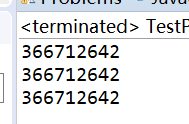1.获取类对象的三种方法
首先定义一个用于测试的类Person:
1 package com.example.reflection; 2 3 public class Person { 4 String name; 5 int age; 6 7 public Person() { 8 super(); 9 System.out.println("Person的无参构造执行了"); 10 } 11 12 public Person(String name, int age) { 13 super(); 14 this.name = name; 15 this.age = age; 16 } 17 18 public void eat() { 19 System.out.println(name + "正在吃东西"); 20 } 21 22 public String getName() { 23 return name; 24 } 25 26 public void setName(String name) { 27 this.name = name; 28 } 29 30 public int getAge() { 31 return age; 32 } 33 34 public void setAge(int age) { 35 this.age = age; 36 } 37 38 @Override 39 public String toString() { 40 return "Person [name=" + name + ", age=" + age + "]"; 41 } 42 43 public void eat(String food) { 44 System.out.println(name + "正在吃" + food); 45 } 46 47 private void prviMethod() { 48 System.out.println("Person的私有方法"); 49 } 50 51 static void staticMethod() { 52 System.out.println("Person的静态方法"); 53 } 54 }
获取类对象有以下三种方式:
(1)通过类的对象获取类对象
(2)通过类名获取类对象
(3)通过静态方法获取类对象
1 package com.example.reflection; 2 3 public class TestPerson { 4 public static void main(String[] args) throws Exception { 5 // 1.使用对象获取类对象 6 Person p = new Person(); 7 Class<Person> cp = (Class<Person>) p.getClass(); 8 System.out.println(cp.hashCode()); 9 10 // 2.使用类名获取类对象 11 Class<Person> cp2 = Person.class; 12 System.out.println(cp2.hashCode()); 13 14 // 3.使用Class的formName()方法 15 Class<Person> cp3 = (Class<Person>) Class.forName("com.example.reflection.Person"); 16 System.out.println(cp3.hashCode()); 17 } 18 }

三种方式获取的是同一个类对象。
2.反射常用方法和操作
反射常用方法有:
public String getName()
public Package getPackage()
public Class<? super T> getSuperclass()
public Class<?>[] getInerfaces()
public Constructor<?>[] getConstructors()
public T newInstance()
public Method[] getMethods()
public Field[] getFields()
2.1获取类的基本信息
1 package com.example.reflection; 2 3 public class active1 { 4 5 public static void main(String[] args) throws Exception { 6 // 通过反射获取类对象 7 Class<?> cp = Class.forName("com.example.reflection.Person"); 8 9 // 1.获取类的名字 10 System.out.println(cp.getName()); 11 12 // 2.获取类的包名 13 System.out.println(cp.getPackage()); 14 15 // 3. 获取类的父类 16 System.out.println(cp.getSuperclass().getName()); 17 18 // 4. 获取类继承的接口 19 for (Class<?> c1 : cp.getInterfaces()) { 20 System.out.println(c1.getName()); 21 } 22 } 23 }

2.2获取类的构造方法,并创建对象
1 package com.example.reflection; 2 3 import java.lang.reflect.Constructor; 4 5 public class active2 { 6 public static void main(String[] args) throws Exception { 7 // 通过反射获取类对象 8 Class<?> cp = Class.forName("com.example.reflection.Person"); 9 10 // 1. 获取所有构造函数 11 for (Constructor<?> ct : cp.getConstructors()) { 12 System.out.println(ct.toString()); 13 } 14 15 // 2. 获取类的无参构造方法 16 Constructor<?> ct2 = cp.getConstructor(); 17 Person p = (Person) ct2.newInstance(null); 18 // p = (Person) cp.newInstance();//简写形式 19 System.out.println(p.toString()); 20 21 // 3.获取类的有参构造方法 22 Constructor<?> ct3 = cp.getConstructor(String.class, int.class); 23 Person p2 = (Person) ct3.newInstance("张三", 18); 24 System.out.println(p2.toString()); 25 } 26 }

2.3获取类的方法,并调用
1 package com.example.reflection; 2 3 import java.lang.reflect.Method; 4 5 public class active3 { 6 7 public static void main(String[] args) throws Exception { 8 // 通过反射获取类对象 9 Class<?> cp = Class.forName("com.example.reflection.Person"); 10 Person p = (Person) cp.newInstance(); 11 12 System.out.println("获取公开的方法和继承的方法"); 13 for (Method m : cp.getMethods()) { 14 System.out.println(m.toString()); 15 } 16 17 System.out.println("获取所有方法,不含继承的"); 18 for (Method m : cp.getDeclaredMethods()) { 19 System.out.println(m.toString()); 20 } 21 22 System.out.println("获取公共方法"); 23 Method eat = cp.getMethod("eat", String.class); 24 eat.invoke(p, "牛肉面"); 25 26 System.out.println("获取私有方法"); 27 Method priv = cp.getDeclaredMethod("prviMethod"); 28 priv.setAccessible(true);//允许执行私有方法 29 priv.invoke(p, null); 30 31 System.out.println("获取静态方法"); 32 Method stac = cp.getDeclaredMethod("staticMethod"); 33 stac.invoke(p, null); 34 } 35 }
2.4实现一个可以调用任何对象的任何方法的方法
1 package com.example.reflection; 2 3 import java.lang.reflect.Method; 4 import java.util.Properties; 5 6 public class active4 { 7 8 public static void main(String[] args) throws Exception { 9 // TODO Auto-generated method stub 10 Properties ps = new Properties(); 11 invoeAny(ps, "setProperty", new Class[] { String.class, String.class }, "username", "zhangsan"); 12 System.out.println(ps.getProperty("username")); 13 } 14 15 public static Object invoeAny(Object obj, String methodName, Class<?>[] types, Object... args) throws Exception { 16 Class<?> cp = obj.getClass(); 17 Method m = cp.getMethod(methodName, types); 18 return m.invoke(obj, args); 19 } 20 }

2.5 获取属性
1 package com.example.reflection; 2 3 import java.lang.reflect.Constructor; 4 import java.lang.reflect.Field; 5 import java.util.Properties; 6 7 public class active5 { 8 public static void main(String[] args) throws Exception { 9 // 通过反射获取类对象 10 Class<?> cp = Class.forName("com.example.reflection.Person"); 11 Constructor<?> ct = cp.getConstructor(String.class, int.class); 12 Person p = (Person) ct.newInstance("张三", 18); 13 14 // 公共和继承的属性 15 for (Field f : cp.getFields()) { 16 System.out.println(f.toString()); 17 } 18 19 for (Field f : cp.getDeclaredFields()) { 20 System.out.println(f.toString()); 21 } 22 23 // 获取属性 24 Field name = cp.getDeclaredField("name"); 25 System.out.println(name); 26 27 // 给属性赋值 28 name.set(p, "法外狂徒"); 29 System.out.println(p.getName()); 30 } 31 }
